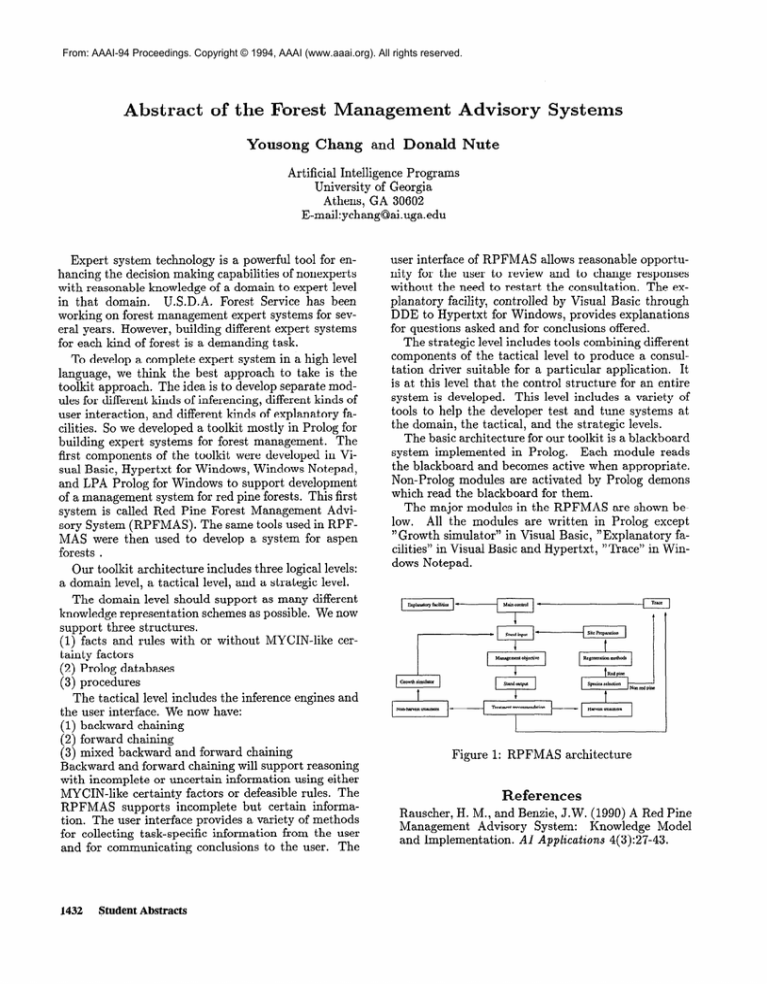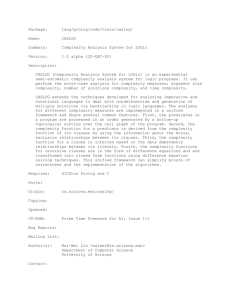
From: AAAI-94 Proceedings. Copyright © 1994, AAAI (www.aaai.org). All rights reserved.
Abstract
of the Forest Management
Advisory
Systems
Yousong Chang and Donald Nute
Artificial Intelligence Programs
University of Georgia
Athens, GA 30602
E-mail:ychang@ai.uga.edu
Expert system technology is a powerful tool for enhancing the decision making capabilities of nonexperts
with reasonable knowledge of a domain to expert level
in that domain.
U.S.D.A.
Forest Service has been
working on forest management
expert systems for several years. However, building different expert systems
for each kind of forest is a demanding task.
To develop a complete expert system in a high level
language, we think the best approach to take is the
toolkit approach. The idea is to develop separate modules for different kinds of inferencing, different kinds of
user interaction,
and different kinds of explanatory facilities. So we developed a toolkit mostly in Prolog for
building expert systems for forest management.
The
first components
of the toolkit were developed in Visual Basic, Hypertxt for Windows, Windows Notepad,
and LPA Prolog for Windows to support development
of a management
system for red pine forests. This first
system is called Red Pine Forest Management
Advisory System (RPFMAS).
The same tools used in RPFMAS were then used to develop a system for aspen
forests .
Our toolkit architecture
a domain level, a tactical
includes three logical levels:
level, and a strategic level.
user interface of RPFMAS
allows reasonable opportunity for the user to review and to change responses
without the need to restart the consultation.
The explanatory facility, controlled by Visual Basic through
DDE to Hypertxt for Windows, provides explanations
for questions asked and for conclusions offered.
The strategic level includes tools combining different
components of the tactical level to produce-a
consultation driver suitable for a particular
application.
It
is at this level that the control structure for an entire
system is developed.
This level includes a variety of
tools to help the developer test and tune systems at
the domain, the tactical, and the strategic levels.
The basic architecture for our toolkit is a blackboard
system implemented
in Prolog.
Each module reads
the blackboard
and becomes active when appropriate.
Non-Prolog
modules are activated by Prolog demons
which read the blackboard for them.
The major modules in the RPFMAS
are shown below.
All the modules are written in Prolog except
“Growth simulator” in Visual Basic, “Explanatory
facilities” in Visual Basic and Hypertxt, “Trace” in Windows Notepad.
The domain level should support as many different
knowledge representation
schemes as possible. We now
support three structures.
(1) facts and rules with or without MYCIN-like
certainty factors
(2) Prolog databases
(3) procedures
The tactical level includes the inference engines and
the user interface.
We now have:
(1) backward chaining
(2) forward chaining
(3) mixed backward and forward chaining
Backward and forward chaining will support reasoning
with incomplete or uncertain information
using either
MYCIN-like
certainty factors or defeasible rules. The
RPFMAS
supports incomplete
but certain information. The user interface provides a variety of methods
for collecting task-specific
information
from the user
and for communicating
conclusions to the user. The
1432
Student Abstracts
Figure
1: RPFMAS
architecture
References
Rauscher, H. M., and Benzie, J.W. (1990) A Red Pine
Management
Advisory System:
Knowledge
Model
and Implementation.
AI AppZications 4(3):27-43.




